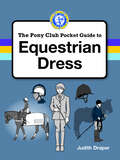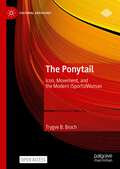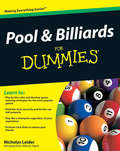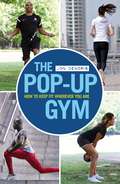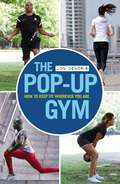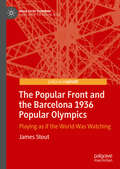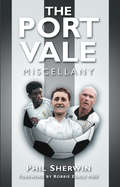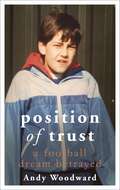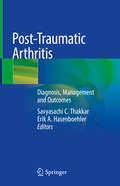- Table View
- List View
PONY CLUB GUIDE TO EQUESTRIAN DRESS: A Pony Club Guide
by Judith DraperThis book is a completely new and important guide to correct, safe and practical clothes for people involved with leisure riding, Pony Club activities, handling and grooming horses. Riding clothes, like all other sportswear, are based on practical design with a certain amount of fashion. This book describes the most suitable type of dress for each activity. The authoritative text, clear design and extensive illustrations make this a must-buy for any young rider.
The Ponytail: Icon, Movement, and the Modern (Sports)Woman (Cultural Sociology)
by Trygve B. BrochThis open access book adopts a cultural sociology of materiality to explore the hallmark of the female athlete: the ponytail. Studying a wealth of news articles about ponytails in sports and society, Broch uncovers this hairstyle’s polyvocality and argues that it is a total social phenomenon. By separating his approach from the cultural studies tradition, Broch highlights how hair is imbued with codes, narratives, and myth that allow its wearers to understand, maneuver, and criticize social gender relations in deeply personal ways. Using multiple theories about hair, bodies, myths, and icons, he creates a multidimensional method to show how icons are imitated and used. As women navigate their practical lives, health issues, and gendered expectations, the ponytail materializes their dynamic maneuvering of cultural and social environments. Sporting a ponytail—itself an embodiment of movement—is filled with a performativity of social movements: a cultural kinetics that is never apolitical.
Pool and Billiards For Dummies
by Nicholas LeiderPractical, step-by-step tips for players of all levels From Snooker to Carom to good-old-fashioned 8- or 9-Ball, Pool & Billiards For Dummies reveals the tips, tricks, and rules of play, covering the variety of the ever-popular games that make up pool and billiards. This hands-on guide discusses everything from the rules and strategies of the games to how to set up a pool room to choosing the right equipment, and is accompanied by dozens of photos and line drawings. See how hard to hit the cue ball and where to hit it, the angle to hold the cue stick and how much chalk to use, how to use a bridge, and how to put spin on the ball Includes advanced pool techniques and trick shots for the seasoned pool sharp With Pool & Billiards For Dummies, even a novice can play like a champion!
Pool and Billiards For Dummies
by Nicholas LeiderPractical, step-by-step tips for players of all levels From Snooker to Carom to good-old-fashioned 8- or 9-Ball, Pool & Billiards For Dummies reveals the tips, tricks, and rules of play, covering the variety of the ever-popular games that make up pool and billiards. This hands-on guide discusses everything from the rules and strategies of the games to how to set up a pool room to choosing the right equipment, and is accompanied by dozens of photos and line drawings. See how hard to hit the cue ball and where to hit it, the angle to hold the cue stick and how much chalk to use, how to use a bridge, and how to put spin on the ball Includes advanced pool techniques and trick shots for the seasoned pool sharp With Pool & Billiards For Dummies, even a novice can play like a champion!
The Pop-up Gym: How to Keep Fit Wherever You Are
by Jon DenorisFitness trainer to a host of busy people including actors, TV presenters and politicians, Jon Denoris has created a series of exercises and routines, most of which can be carried out almost anywhere: in the home, at work or outdoors. Hardly any of them require any equipment. Dumbbells and a medicine ball will come in useful for a few of the exercises, and also a stability ball, but that is all. So the exercises can even be done on holiday and can be adapted to work with stand-in equipment. Hence the title The Pop-up Gym: a fitness programme you can take with you wherever you go. An easy-to-use, stylish package for people who want to be fit with the minimum of fuss. Suitable for readers who don't have time to go to a gym, don't want to spend a lot of money on equipment and have limited time.
The Pop-up Gym: How to Keep Fit Wherever You Are
by Jon DenorisFitness trainer to a host of busy people including actors, TV presenters and politicians, Jon Denoris has created a series of exercises and routines, most of which can be carried out almost anywhere: in the home, at work or outdoors. Hardly any of them require any equipment. Dumbbells and a medicine ball will come in useful for a few of the exercises, and also a stability ball, but that is all. So the exercises can even be done on holiday and can be adapted to work with stand-in equipment. Hence the title The Pop-up Gym: a fitness programme you can take with you wherever you go. An easy-to-use, stylish package for people who want to be fit with the minimum of fuss. Suitable for readers who don't have time to go to a gym, don't want to spend a lot of money on equipment and have limited time.
Poppy and the Perfect Pony (Sunshine Stables #1)
by Olivia TuffinAt Sunshine Stables, dreams become adventures! Young pony fans will love this fantastic pony club series from Olivia Tuffin.Poppy can't wait to start pony club and ride beautiful Silver Shadow. But on her first day she's paired with kind but lumpy Henry. She's determined to find a way back to her dream pony, though it seems that Henry has other ideas. . . Packed with adventure and full of heart, Olivia's huge knowledge and passion for ponies shines on every page. Beautifully illustrated throughout by Jo Goodberry, this is a perfect pony story for readers aged 7+.Don't miss the other Sunshine Stables stories!Sophie and the Spooky PonyGracie and the Grumpy Pony
Popular Culture in a New Age
by Marshall FishwickWith a Foreword by Dr. Fishwick's student--Tom Wolfe.This book redefines popular culture in the light of the revolutionary changes brought about by the information revolution and the digital divide. It explores the phenomenal growth and extension of popular culture in the last decade and ties in the vast changes brought about by technology and the Internet. In an era when American television and the Internet reach virtually every corner of the globe, Popular Culture in a New Age shows how the poorly understood and often underestimated area known as popular culture affects all of our lives.Beginning with an evaluation of the millennium celebrations and the enormous error of Y2K madness, Popular Culture in a New Age then moves on to the “New Gold Rush” brought about by technology and takes a hard look at its risks. The book examines a wide variety of pop culture phenomena such as carnivals, celebrities, and the road from nineteenth century humbuggery (P. T. Barnum's term) to today's hype.In Popular Culture in a New Age you'll learn about: the three faces of popular culture: folk, fake, and pop--how they relate and how they differ today's popular icons the empire of Disney World Marshall McLuhan, our era's most profound and shocking electronic thinker African-American popular culture and stylePopular Culture in a New Age gives characterization to the postmodern world in a chapter on “postmodern pop,” followed by the shift from civil religion to civil disobedience and the “myth of success.” This insightful book will help you understand the way we eat, think, vote, and respond to our fast-changing world in the era of hype, spin doctors, chat rooms, and jargon.
Popular Culture in a New Age
by Marshall FishwickWith a Foreword by Dr. Fishwick's student--Tom Wolfe.This book redefines popular culture in the light of the revolutionary changes brought about by the information revolution and the digital divide. It explores the phenomenal growth and extension of popular culture in the last decade and ties in the vast changes brought about by technology and the Internet. In an era when American television and the Internet reach virtually every corner of the globe, Popular Culture in a New Age shows how the poorly understood and often underestimated area known as popular culture affects all of our lives.Beginning with an evaluation of the millennium celebrations and the enormous error of Y2K madness, Popular Culture in a New Age then moves on to the “New Gold Rush” brought about by technology and takes a hard look at its risks. The book examines a wide variety of pop culture phenomena such as carnivals, celebrities, and the road from nineteenth century humbuggery (P. T. Barnum's term) to today's hype.In Popular Culture in a New Age you'll learn about: the three faces of popular culture: folk, fake, and pop--how they relate and how they differ today's popular icons the empire of Disney World Marshall McLuhan, our era's most profound and shocking electronic thinker African-American popular culture and stylePopular Culture in a New Age gives characterization to the postmodern world in a chapter on “postmodern pop,” followed by the shift from civil religion to civil disobedience and the “myth of success.” This insightful book will help you understand the way we eat, think, vote, and respond to our fast-changing world in the era of hype, spin doctors, chat rooms, and jargon.
The Popular Front and the Barcelona 1936 Popular Olympics: Playing as if the World Was Watching (Mega Event Planning)
by James StoutThis book deals with the events leading up to the 1936 Popular Olympics which would have united the Popular Front in opposition to the Berlin Olympics. It also discusses the days after the outbreak of the Spanish Civil War which began on the same day the games were due to start. Using a variety of primary and secondary sources, the book traces the biographies of several Popular Olympians who would go on to volunteer in the Spanish Civil War. The book also examines the planned events and locations for the Popular Olympics as well as the international funding that the games secured. The book argues that the events were a departure from Workers’ Sport as well as the IOC’s Olympic games and represented an important cultural manifestation of the Popular Front.
The Port Vale Miscellany
by Phil SherwinThe Port Vale Miscellany – a book on the Valiants like no other, packed with facts, stats, trivia, stories and legends. Port Vale Football Club – the name gives no clue to its whereabouts, but this book tells all of the highs, lows and downright strange happenings at a club that has been in existence in the Potteries for over 130 years. From an FA Cup semi-final to expulsion from the league, from three Wembley appearances to a ten-goal home defeat when the goalkeeper lost his glasses in the mud, it’s all here. Classic giant-killings, the man who played for both teams in the same game, going into administration, famous fans such as Robbie Williams and Phil Taylor, they all have a story to tell. The record wins, defeats, attendances and plenty of facts about the club are listed in great detail, plus the answer to many questions such as what links David Beckham and Bobby Charlton to Port Vale?
Position of Trust: A football dream betrayed
by Andy Woodward'Harrowing, brave, hugely important book' HENRY WINTER'Absolutely amazed by the power of Andy Woodward's testimony' JEREMY VINE SHOW'I'm sure this will be one of the defining football books of the era' SAM WALLACE, CHIEF FOOTBALL WRITER FOR THE TELEGRAPHThe brave and moving account by football's first whistle blower, breaking the silence on the scandal of sexual abuse in youth clubs and junior teams.Essential reading for parents, and for anyone afraid to speak up.Andy Woodward was a wide eyed, hopeful footballer playing for Stockport Boys, when Barry Bennell first noticed him. Andy was 11 years old, and Bennell a youth coach with a big reputation for spotting and nurturing young footballing talent. The clubs Bennell worked for and the parents of the boys he coached, trusted and believed in him, inviting him into their lives and their homes. But behind the charismatic mask was a profoundly evil man willing to go to any lengths to satisfy his own dark appetites. Andy has been heralded a hero for speaking up about his horrific experiences at the hands of Bennell, but also at going further to expose the long hidden abuse buried within our nations' best loved sport. His story is only the tip of the iceberg.Andy's childhood was shattered by what happened to him and by the fear and silence that surrounded it. His youthful dreams of playing the game he loved were utterly broken, and years of living with the terrible secret and shame all but destroyed him. He hopes that by coming forward he might encourage others in similar situations to find the courage to speak out. A compelling and relevant story of the dark secret at the heart of football and another chapter in the ongoing expose of institutionalised corruption.
Positive Pedagogy for Sport Coaching
by Stephen Harvey Richard LightPositive Pedagogy is an athlete-centred, inquiry based approach that transforms the way we understand learning and coaching in sport. This book demonstrates how Positive Pedagogy for sport coaching (PPed) can be successfully employed across a range of sports and levels of performance, while also providing insight into coaches’ experiences. Now in a fully revised and updated second edition, the book introduces the key concepts that underpin positive pedagogy and offers detailed case studies of positive pedagogy in action, with reflections from practising coaches. It also provides more detail and direction for coaches interested in implementing the approach. This new edition moves beyond coaching in individual sports to explain how positive pedagogy can be applied to all sport coaching, across a wide range of sports including basketball, baseball, football, rugby, boxing, swimming, track and field athletics, as well as strength and conditioning. Positive Pedagogy for sport coaching both improves performance and promotes positive learning experiences across all ages and abilities. This book is invaluable reading for all sports coaching students as well as any practising coach or physical education teacher looking to improve or even transform their professional practice.
Positive Pedagogy for Sport Coaching: Athlete-centred coaching for individual sports
by Richard LightThe concept of positive pedagogy has transformed the way we understand learning and coaching in sport. Presenting examples of positive pedagogy in action, this book is the first to apply its basic principles to individual sports such as swimming, athletics, gymnastics and karate. Using the game based approach (GBA) (an athlete-centred, inquiry-based method that involves game-like activities), this book demonstrates how positive pedagogy can be successfully employed across a range of sports and levels of performance, while also providing insight into coaches’ experiences of this approach. Divided into three sections that focus on the development, characteristics and applications of positive pedagogy, it fills a gap in coaching literature by extending the latest developments of GBA to activities beyond team sports. It pioneers a way of coaching that is both efficient in improving performance and effective in promoting positive experiences of learning across all ages and abilities. Positive Pedagogy for Sport Coaching: Athlete-centred coaching for individual sports is invaluable reading for all sports coaching students as well as any practising coach or physical education teacher looking for inspiration.
Positive Pedagogy for Sport Coaching: Athlete-centred coaching for individual sports
by Richard Light Stephen HarveyPositive Pedagogy is an athlete-centred, inquiry-based approach that transforms the way we understand learning and coaching in sport. This book demonstrates how Positive Pedagogy for sport coaching (PPed) can be successfully employed across a range of sports and levels of performance, while also providing insight into coaches’ experiences. Now in a fully revised and updated second edition, the book introduces the key concepts that underpin Positive Pedagogy and offers detailed case studies of Positive Pedagogy in action, with reflections from practising coaches. It also provides more detail and direction for coaches interested in implementing the approach. This new edition moves beyond coaching in individual sports to explain how Positive Pedagogy can be applied to all sport coaching across a wide range of sports, including basketball, baseball, football, rugby, boxing, swimming, track and field athletics, as well as strength and conditioning. Positive Pedagogy for sport coaching both improves performance and promotes positive learning experiences across all ages and abilities. This book is invaluable reading for all sports coaching students as well as any practising coaches or physical education teachers looking to improve or even transform their professional practice.
Positive Psychology and the Body: The Somatopsychic Side To Flourishing (UK Higher Education OUP Psychology Psychology)
by Kate HefferonAs positive psychology continues to make leaps and bounds in terms of scientific advancement, the focus on the importance of the body within optimal functioning is still lagging. Positive Psychology and the Body provides a critical reflection on this omission, highlighting the mounting corpus of scientific research completed on the physical mechanisms which assist either momentary experiences of pleasure or longer-lasting feelings of meaning and self development.Indispensable reading for students of well-being, positive psychology and sports psychology, the book spans topics such as physical activity, genetics, interpersonal touch, positive sexual behaviours, nutrition and many more. Those studying and researching coaching, health, clinical psychology and counselling psychology will also find the book valuable reading. With contributions from Angela Clow and Michael Pluess. "Finally, an author has addressed the white elephant in the room: the human body. Arguably one of the most important aspects of the self the body has long been overlooked by positive psychologists as a serious point of study. This book has it all: from sex to genetics to illness Hefferon brings an expert review of research, clear advice and fresh thinking."Dr. Robert Biswas-Diener, Managing Director, Positive Acorn, LLC"With this fine textbook, Positive Psychology expands its scope considerably, to include new and important perspectives from the very foundation of any psyche: the body. Indeed, we may argue that as much as any organ, the psyche is part of the body, if certainly still very strangely so. Kate Hefferon with her colleagues are to be strongly applauded for making new understandings of the mind-body-unity so accessible to students and everyone else interested in this fascinating topic." Hans Henrik Knoop, Aarhus University, Denmark and President, European Network for Positive Psychology"In a field - positive psychology - overcrowded with simplistic treatments of happiness and the good life, Kate Hefferon has put together a truly original book. By linking principles of positive psychology with the body, Hefferon brings to light the need for a more holistic approach to the good life, one that honors the reality that we carry out this project called "life" tethered to this world through our bodies. Anybody interested in a more grounded positive psychology should read this book."Corey L. M. Keyes, Professor of Sociology, Emory University, USA"In showing the relevance of positive psychology to sexuality, nutrition, health and physical activity Kate Hefferon pushes the boundaries of positive psychology into new territory. Packed with ideas that we can apply in our own lives, students and others interested in positive psychology will find this book an excellent introduction. Well worth the time to read."Stephen Joseph, author of What Doesn't Kill Us: The New Psychology of Posttraumatic Growth
Positive Psychology in Sport and Physical Activity: An Introduction
by Abbe Brady Bridget Grenville-CleavePositive psychology (PP) is a fast-developing area of research that emphasises personal growth and the positive qualities of life. This is the first book to apply the principles and practice of PP to sport and physical activity. In attempting to help people enjoy sport, sport psychology has paradoxically often focused on topics such as anxiety, stress and burnout. By contrast, this reader-friendly introduction to PP shows how it can improve sporting performance while also enhancing physical and mental well-being. Demonstrating the practical relevance of PP for all those who participate in sport and physical activity at any level, it covers a variety of topics including: passion, enjoyment and flow positive pedagogy and appreciative inquiry for sport leaders, coaches and teachers gratitude, mindfulness, optimism and hope positive psychology coaching for sport leaders and practitioners character strengths, growth mindset and resilience. With expert contributors from around the globe, real-life case studies, practical strategies and suggestions for future research in every chapter, this book is inspirational reading for all students, coaches, researchers and practitioners with an interest in sport and exercise psychology, mental health and well-being.
Positive Psychology in Sport and Physical Activity: An Introduction
by Abbe Brady Bridget Grenville-CleavePositive psychology (PP) is a fast-developing area of research that emphasises personal growth and the positive qualities of life. This is the first book to apply the principles and practice of PP to sport and physical activity. In attempting to help people enjoy sport, sport psychology has paradoxically often focused on topics such as anxiety, stress and burnout. By contrast, this reader-friendly introduction to PP shows how it can improve sporting performance while also enhancing physical and mental well-being. Demonstrating the practical relevance of PP for all those who participate in sport and physical activity at any level, it covers a variety of topics including: passion, enjoyment and flow positive pedagogy and appreciative inquiry for sport leaders, coaches and teachers gratitude, mindfulness, optimism and hope positive psychology coaching for sport leaders and practitioners character strengths, growth mindset and resilience. With expert contributors from around the globe, real-life case studies, practical strategies and suggestions for future research in every chapter, this book is inspirational reading for all students, coaches, researchers and practitioners with an interest in sport and exercise psychology, mental health and well-being.
Positive Sociology of Leisure: Contemporary Perspectives (Leisure Studies in a Global Era)
by Karl Spracklen Anju Beniwal Shintaro Kono Priyanka BawejaThis edited collection explores Positive Sociology of Leisure (PSL) as a subfield relating to leisure studies, sociology of leisure, and sociology of happiness. Defined as an area of research that examines social aspects of leisure life with a focus on the optimal functioning of relationship, group, community, organization, and other social units, PSL differs from more critical forms of sociology in that its starting point is social positives. The contributions draw on a range of diverse disciplinary backgrounds to consider various meanings of leisure across themes such as: ageing; sex, sexuality and family; community, youth, and education; and arts and creativity. Positive Sociology of Leisure will be a key reference within the field of sociology of leisure, as well as an important introductory book for those interested in leisure studies.
Positive Youth Development through Sport: second edition
by Nicholas L. HoltCutting through the political rhetoric about the power of sport as a tool for social change and personal improvement, this book offers insight into how and why participating in sport can be good for children and young people. As the first text to focus on the role of sport in positive youth development (PYD), it brings together high-profile contributors from diverse disciplines to examine critically the ways in which sport can be used to promote youth development. Now in a fully updated, revised and expanded new edition, Positive Youth Development through Sport covers a wider range of disciplines including sport psychology, development psychology, physical education, sport development and sport sociology. Its three main sections focus on: the theoretical and historical contexts of PYD quantitative and qualitative methods for assessing PYD in sport the potential of PYD in sport across different ages and abilities. With expanded guidance on how to apply positive youth development in practice, this is essential reading for all students, researchers, educators, practitioners and policy makers with an interest in youth sport.
Positive Youth Development through Sport: second edition (Routledge Studies In Physical Education And Youth Sport Ser.)
by Nicholas L. HoltCutting through the political rhetoric about the power of sport as a tool for social change and personal improvement, this book offers insight into how and why participating in sport can be good for children and young people. As the first text to focus on the role of sport in positive youth development (PYD), it brings together high-profile contributors from diverse disciplines to examine critically the ways in which sport can be used to promote youth development. Now in a fully updated, revised and expanded new edition, Positive Youth Development through Sport covers a wider range of disciplines including sport psychology, development psychology, physical education, sport development and sport sociology. Its three main sections focus on: the theoretical and historical contexts of PYD quantitative and qualitative methods for assessing PYD in sport the potential of PYD in sport across different ages and abilities. With expanded guidance on how to apply positive youth development in practice, this is essential reading for all students, researchers, educators, practitioners and policy makers with an interest in youth sport.
Post-Traumatic Arthritis: Pathogenesis, Diagnosis and Management
by Steven A. Olson Farshid GuilakBringing together the most up-to-date research on post-traumatic arthritis (PTA) and its management, this book is a comprehensive presentation of the current thinking on all aspects of the mechanisms of joint injury and subsequent development of PTA. Divided into thematic sections, it includes discussions of the incidence and burden of PTA, both in society at large and in the military population specifically; the relevant experimental work on PTA, from basic science to animal models; peri-articular tissue responses to of joint injury and potential mechanisms of PTA; the current clinical assessment and treatment of common joint injuries leading to PTA; and emerging technologies and treatments for PTA, including biomarkers and stem cell therapies. Taken together, it will be an invaluable resource for orthopedic surgeons, rheumatologists and other joint injury researchers and clinicians.
Post-Traumatic Arthritis: Diagnosis, Management and Outcomes
by Savyasachi C. Thakkar Erik A. HasenboehlerThe incidence and prevalence of post-traumatic arthritis (PTA) is increasing globally due to longevity of life and increased activity and injuries. Compared to the non-traumatic etiology of arthritis, post-traumatic arthritis differs in presentation, severity and complexity of management. This book illustrates all pertinent facets of post-traumatic arthritis, from the basic science and diagnostic modalities to their management and outcomes. The opening section reviews the current scientific literature on PTA and presents the preferred imaging techniques and interpretation methods. A unique chapter on the economic impact of PTA is also included here. The subsequent two sections discuss both the upper and lower extremity, respectively, with each joint covered in a dedicated chapter of its own, describing the mechanisms of injury, assessment, management strategies and outcomes. Case material provides real-world context for the concepts and techniques presented, supported by generous radiology and intraoperative photos and figures.With Post-Traumatic Arthritis, orthopedic surgeons, as well as trauma surgeons, rheumatologists and associated clinical staff, will receive a comprehensive framework on which to base their clinical decisions and enhance their post-operative outcomes.
Posterior Cruciate Ligament Injuries: A Practical Guide to Management
by Gregory C. FanelliNow in a revised and expanded second edition including ten new chapters, this classic text on the diagnosis and management of posterior cruciate ligament injuries represents the state of the art. Comprehensive and used-friendly, the book covers PCL anatomy and biomechanics, diagnosis and evaluation, and both surgical and non-surgical treatment strategies. Surgical chapters discuss graft selection and open and arthroscopic techniques, including both primary and revision surgery and combined reconstruction with other knee ligaments. New chapters illustrate cutting-edge and advanced surgical techniques in reconstruction and primary repair, articular cartilage resurfacing and meniscus transplant in the PCL injured knee, mechanical graft tensioning, the role of osteotomy, treatment of PCL injuries in children, results of treatment and outcomes data in PCL injuries, clinical case studies, and the editor’s experience chapter based on 24 years of treating PCL injuries. Complications, bracing and rehabilitation round out the presentation. Written and edited by leaders in the management of injuries to the knee, this will be an invaluable text for orthopedic surgeons and sports medicine practitioners alike.
Posterior Hip Disorders: Clinical Evaluation and Management
by Hal D. Martin Juan Gómez-HoyosThis unique and comprehensive text discusses the main causes of posterior hip pathology and recent advances in evaluation and treatment of those conditions, including posterior hip pain caused by discogenic, intrapelvic and extrapelvic disorders. Opening with description of the specific anatomy and biomechanics of the posterior hip and the etiology of hip disease, the next few chapters superbly discuss and illustrate the clinical, psychological and radiological assessment of the patient. Analysis with differential diagnosis of various causes of posterior hip pain, including nerve entrapment and impingement, is then presented in detail, followed by discussion of the essentials of the lumbopelvic complex as a source of pain. Later chapters cover vascular claudication as a cause of posterior hip pain, how to evaluate and manage the perioperative scenario, and physical therapy evaluation and treatment. Presenting the latest in examination, diagnostic tools, and surgical and therapeutic techniques from around the world, Posterior Hip Disorders is a solid resource for current and future generations of orthopedic surgeons, radiologists, physiatrists, spine surgeons, sports medicine specialists, rheumatologists, primary care physicians, and physical therapists.
